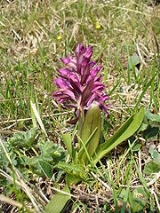
Dactylorhiza sambucina
Encyclopedia
The Elder-flowered Orchid (Dactylorhiza sambucina) is an herbaceous
plant belonging to the family Orchidaceae
.
) emanating by some plants of this species.
The scientific binomial name of this plant was initially Orchis smabucina, proposed by the Swedish naturalist and botanist Carl von Linné (1707–1778) in 1755. The name has been subsequently amended to the one currently accepted (Dactylorhiza sambucina), by the Hungarian botanist Károly Rezső Soó (1903–1980) in 1962. In German this plant is called Holunders-Knabenkraut, in French is called Orchis à odeur de sureau, in Italy is called Orchide sambucina.
This orchid has a short, quarrying and tubulous stem. The leaves are amplexicaul and vary from 4 to 7, the lower ones are oblong-obovate with obtuse apex, while the upper leaves are lanceolate with acute apex. Size of leaves: width 1 to 2.5 cm, length 6 – 12 cm.
The underground part of the stem has two webbed tubers each one more or less deeply divided into several lobes or tubercles (characteristic of the genus Dactylorhiza), the first one plays the important functions of supplying the stem, while the second one collects nutrient materials for the development of the plant that will form in the coming year.
The inflorescence is 5–10 cm (2–3.9 ) long and it is composed of flowers gathered in dense spikes. The flowers are placed in the axils of bracts membranous and lanceolate-shaped. The flowers reaches on average 10–15 cm (3.9–5.9 ) and bloom from mid-April to early July. Their colors vary from yellow with light reddish stains or purple speckled with darker spots on the labellum
.
They are hermaphrodite
and pollinated by insects entomophily
, especially bumblebees (Bombus species, Apidae
). These orchids are almost without nectar, but they are visited by various pollinator insects as they are confused with other plants with nectar. The seeds germination is conditioned by the presence of specific fungi.
Herbaceous
A herbaceous plant is a plant that has leaves and stems that die down at the end of the growing season to the soil level. They have no persistent woody stem above ground...
plant belonging to the family Orchidaceae
Orchidaceae
The Orchidaceae, commonly referred to as the orchid family, is a morphologically diverse and widespread family of monocots in the order Asparagales. Along with the Asteraceae, it is one of the two largest families of flowering plants, with between 21,950 and 26,049 currently accepted species,...
.
Etymology
The name of the genus Dactylorhiza is formed from Greek words δάκτυλος "daktylos" meaning "finger" and ρίζα "rhiza" meaning "root" and refers to the tubers of this plant, that are split into several tubercles. The specific Latin name "sambucina", should refer to the smell of Elder (Sambucus nigraSambucus nigra
Sambucus nigra is a species complex of elder native to most of Europe.It is most commonly called Elder, Elderberry, Black Elder, European Elder, European Elderberry, European Black Elderberry, Common Elder, or Elder Bush when distinction from other species of Sambucus is needed...
) emanating by some plants of this species.
The scientific binomial name of this plant was initially Orchis smabucina, proposed by the Swedish naturalist and botanist Carl von Linné (1707–1778) in 1755. The name has been subsequently amended to the one currently accepted (Dactylorhiza sambucina), by the Hungarian botanist Károly Rezső Soó (1903–1980) in 1962. In German this plant is called Holunders-Knabenkraut, in French is called Orchis à odeur de sureau, in Italy is called Orchide sambucina.
Description
Dactylorhiza sambucina reaches on average 10–40 cm (3.9–15.7 ) of height. These plants are bulbous geophytes, as they bring their buds in underground tubers or bulbs, organs that annually produce new stems, leaves and flowers. Furthermore these orchids are "terrestrial", because unlike "epiphyte" species do not live at the expense of other plants of major sizes.This orchid has a short, quarrying and tubulous stem. The leaves are amplexicaul and vary from 4 to 7, the lower ones are oblong-obovate with obtuse apex, while the upper leaves are lanceolate with acute apex. Size of leaves: width 1 to 2.5 cm, length 6 – 12 cm.
The underground part of the stem has two webbed tubers each one more or less deeply divided into several lobes or tubercles (characteristic of the genus Dactylorhiza), the first one plays the important functions of supplying the stem, while the second one collects nutrient materials for the development of the plant that will form in the coming year.
The inflorescence is 5–10 cm (2–3.9 ) long and it is composed of flowers gathered in dense spikes. The flowers are placed in the axils of bracts membranous and lanceolate-shaped. The flowers reaches on average 10–15 cm (3.9–5.9 ) and bloom from mid-April to early July. Their colors vary from yellow with light reddish stains or purple speckled with darker spots on the labellum
Labellum
Labellum is the Latin diminutive of labium, meaning lip. These are anatomical terms used descriptively in biology, for example in Entomology and botany.-Botany:...
.
They are hermaphrodite
Hermaphrodite
In biology, a hermaphrodite is an organism that has reproductive organs normally associated with both male and female sexes.Many taxonomic groups of animals do not have separate sexes. In these groups, hermaphroditism is a normal condition, enabling a form of sexual reproduction in which both...
and pollinated by insects entomophily
Entomophily
Entomophily is a form of pollination whereby pollen is distributed by insects. Several insect are reported to be responsible for the pollination of many plant species, particularly bees, Lepidoptera , wasps, flies, ants and beetles. Some plant species co-evolved with a particular pollinator, such...
, especially bumblebees (Bombus species, Apidae
Apidae
The Apidae are a large family of bees, comprising the common honey bees, stingless bees , carpenter bees, orchid bees, cuckoo bees, bumblebees, and various other less well-known groups...
). These orchids are almost without nectar, but they are visited by various pollinator insects as they are confused with other plants with nectar. The seeds germination is conditioned by the presence of specific fungi.

